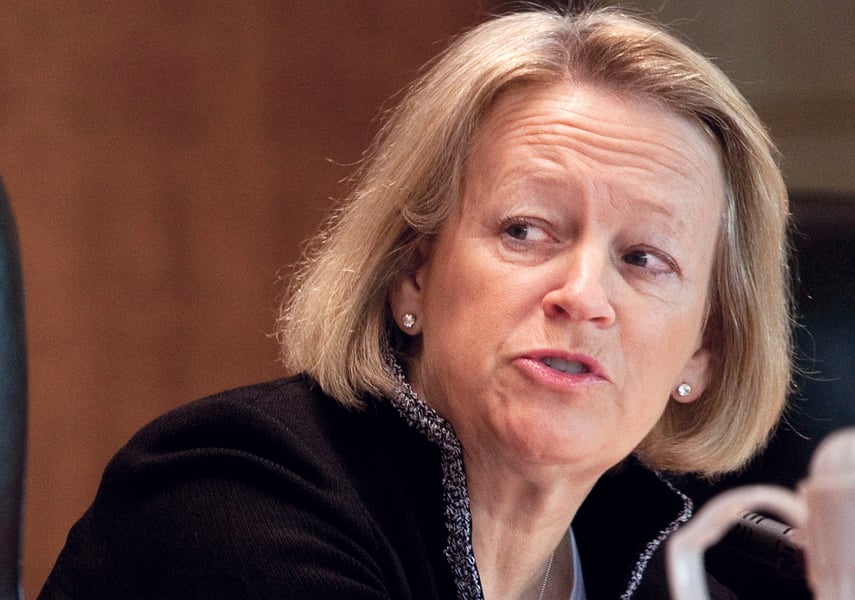U.S. Securities and Exchange Commission member Daniel Gallagher, who helped derail efforts to tighten rules for money market mutual funds, said he would likely support a measure forcing the industry to abandon its marquee $1 share price.
Requiring money funds to have a fluctuating share price “is an attractive option that I am likely to support,” Gallagher, a Republican, said in an interview.
Gallagher's remarks could help revive the debate at the SEC and offer a path toward compromise for SEC Chairman Mary Schapiro, whose proposal ran aground last month.
Gallagher said he couldn't vote for Schapiro's plan because its centerpiece was to make the funds hold extra capital. The cushion was too small to protect investors, Gallagher said, leading him to believe the money would be used as collateral in case the funds needed to borrow from the Federal Reserve.
“I could not be complicit in a rulemaking that purported to eliminate bailouts but would actually do the opposite,” Gallagher said.
SEC spokeswoman Judith Burns declined to comment.
The Financial Stability Oversight Council, an umbrella group of U.S. regulators headed by Treasury Secretary Timothy F. Geithner, may discuss money funds at a meeting tomorrow. Schapiro, a member of the council, has asked the group to consider taking action to stabilize money funds.
Lobbying Campaign
Much of the mutual fund industry -- led by Boston-based
Fidelity Investments and Pittsburgh-based Federated Investors Inc. (FII) -- has waged a long lobbying campaign against any SEC action, especially giving up the stable share price.
The SEC, along with the Fed and Treasury Department, has pressed to make money funds safer since the September 2008 collapse of the $62.5 billion Reserve Primary Fund, which triggered an industrywide run and helped freeze credit markets. The crisis calmed only after the Treasury temporarily guaranteed shareholders against losses and the Fed began buying fund assets at face value to help them meet redemptions.
Schapiro has argued that the funds' $1 share price encourages investors to flee at the first sign of trouble. That's because those who react quickly can sell their shares at $1 each even if the net asset value has dropped below that level.
The industry has maintained that a floating share price would make money funds unworkable for many investors by saddling them with new accounting and tax obligations. In addition, insurers, municipalities and other large users of money funds are often legally bound to invest assets they account for as cash in funds with a stable share price.
Two Options
Schapiro gave up on her plan on Aug. 22 after three of the five commissioners -- Republicans Gallagher and Troy Paredes, joined by Democrat Luis Aguilar -- told her they wouldn't vote to issue it for public comment. Her proposal spelled out two options, the capital cushion coupled with some restrictions on redemptions, or the floating share price.
In a statement that day she urged “other policy makers” to take up the issue saying it was too important to “put our head in the sand and wish it away.”
Gallagher previously expressed skepticism of the SEC's proposals while stopping short of rejecting a floating share price. In a December speech, Gallagher said the commission should first analyze the impact of money market rules the SEC put into place in 2010, saying that “any rulemaking in this space could be premature, and possibly unnecessary.”
Further Study
Gallagher also said a measure forcing funds to abandon the stable $1 share price “is an important option to keep on the table and to subject to further study and consideration.”
On Aug. 28, Gallagher and Paredes said they supported an alternative that would allow firms running money funds to prohibit withdrawals to stop investor flight in the event of a run. They backed Aguilar's call for further study on whether new rules could cause investors to move money from money-market funds to other unregulated investments.
In the interview, Gallagher said his support of a floating share price was contingent on the SEC “fully understanding and addressing” the tax and accounting issues that could arise with the change. Gallagher said a fluctuating share price may need to be coupled with other protections, such as the freezing redemptions option that he and Paredes had suggested.
While Schapiro's plan offered the variable share price as one alternative, Gallagher said it was secondary to the capital buffer. The proposal included about 150 pages describing the capital buffer and just 40 pages on the floating share price.
'Stalking Horse'
“It was intended to act as a stalking horse to push the industry to support the capital buffer proposal,” he said.
While Schapiro's plan did not say the capital could be used for collateral for borrowing from the Fed, Gallagher said, “I came to understand that this is likely what was intended.”
Setting up a Fed-run lending program for money funds during an emergency would help the largest banks continue to fund their own operations via the short-term credit markets while not protecting the companies and individual investors who rely on money funds as a safe place to park their cash, Gallagher said.
Regulators rejected an earlier proposal to create a liquidity facility for the industry in part because it could have opened the door for Fed lending.
“This whole exercise has been about the role that money market funds play in the short-term funding markets on which banks rely, something that FSOC members are very concerned about,” Gallagher said. “It was never really about investors.”
--Bloomberg News--







